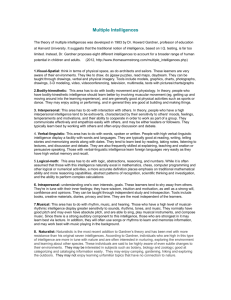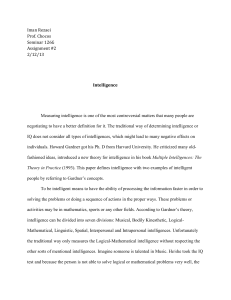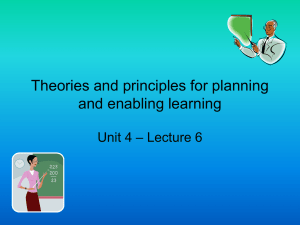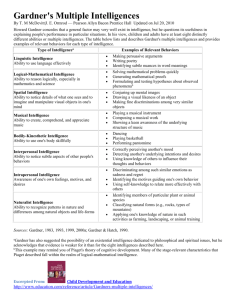Howard Gardner and His Theory of Multiple
advertisement
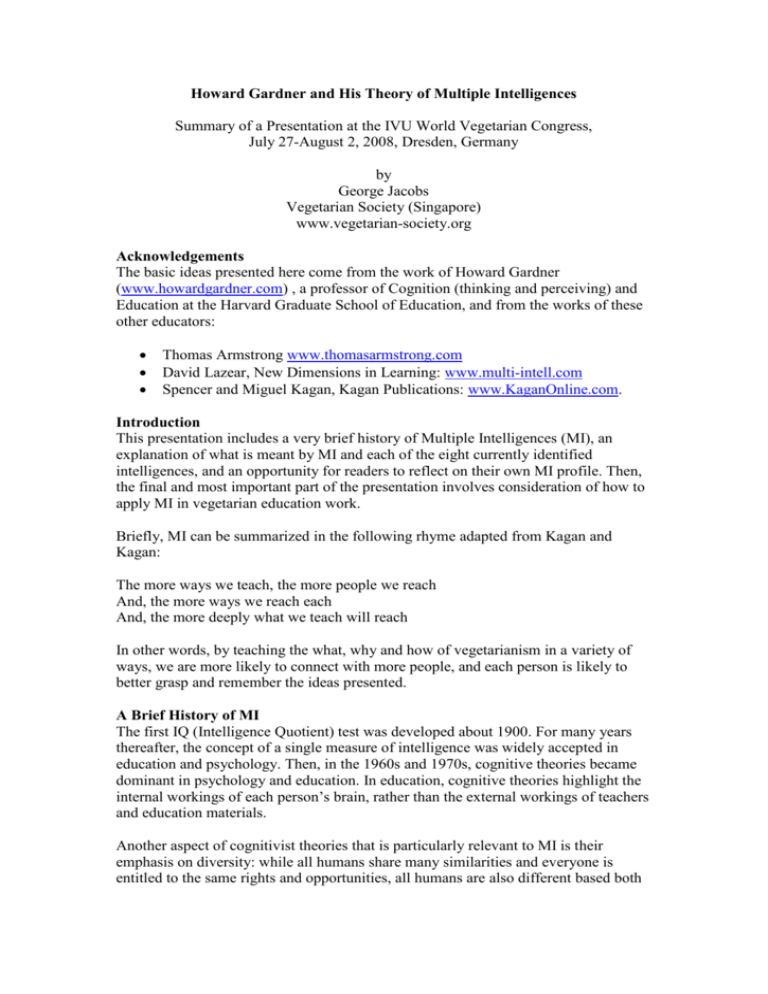
Howard Gardner and His Theory of Multiple Intelligences Summary of a Presentation at the IVU World Vegetarian Congress, July 27-August 2, 2008, Dresden, Germany by George Jacobs Vegetarian Society (Singapore) www.vegetarian-society.org Acknowledgements The basic ideas presented here come from the work of Howard Gardner (www.howardgardner.com) , a professor of Cognition (thinking and perceiving) and Education at the Harvard Graduate School of Education, and from the works of these other educators: Thomas Armstrong www.thomasarmstrong.com David Lazear, New Dimensions in Learning: www.multi-intell.com Spencer and Miguel Kagan, Kagan Publications: www.KaganOnline.com. Introduction This presentation includes a very brief history of Multiple Intelligences (MI), an explanation of what is meant by MI and each of the eight currently identified intelligences, and an opportunity for readers to reflect on their own MI profile. Then, the final and most important part of the presentation involves consideration of how to apply MI in vegetarian education work. Briefly, MI can be summarized in the following rhyme adapted from Kagan and Kagan: The more ways we teach, the more people we reach And, the more ways we reach each And, the more deeply what we teach will reach In other words, by teaching the what, why and how of vegetarianism in a variety of ways, we are more likely to connect with more people, and each person is likely to better grasp and remember the ideas presented. A Brief History of MI The first IQ (Intelligence Quotient) test was developed about 1900. For many years thereafter, the concept of a single measure of intelligence was widely accepted in education and psychology. Then, in the 1960s and 1970s, cognitive theories became dominant in psychology and education. In education, cognitive theories highlight the internal workings of each person’s brain, rather than the external workings of teachers and education materials. Another aspect of cognitivist theories that is particularly relevant to MI is their emphasis on diversity: while all humans share many similarities and everyone is entitled to the same rights and opportunities, all humans are also different based both on their genetic makeup, as well as their unique individual experiences. This diversity, when understood and appreciated, provides a great source of strength. In the 1980s, Howard Gardner, a proponent of cognitivist perspectives, developed MI theory based on eight criteria for deciding what constitutes an intelligence: i. Potential isolation by brain damage. ii. The existence of idiot savants, prodigies and other exceptional individuals. iii. An identifiable core operation or set of operations. iv. A distinctive development history, along with a definable set of 'end-state' performances. v. An evolutionary history and evolutionary plausibility. vi. Support from experimental psychological tasks. vii. Support from psychometric findings. viii. Susceptibility to encoding in a symbol system. Other theorists, such as Robert Sternberg, have developed other theories involving a variety of intelligences. What MI Theory Says MI is a very optimistic intelligence theory. It states that intelligence is not a unitary construct, that instead there are many ways to be smart. Indeed, everyone is smart, and in different ways. On another optimistic note, Gardner claims that intelligence is not fixed, and that we can all, even adults, become smarter. Exactly what constitutes an intelligence is a matter of some debate. Nonetheless, it should be understood that ‘intelligence’ is not a synonym for ‘skill’ or ‘ability’. Intelligences are also about preferences, how people enjoy doing things, what their favourite modes of learning are. Furthermore, intelligences seldom work alone; almost any task involves two or more intelligences. An MI Survey One excellent way to understand MI is to take the MI survey found in Armstrong’s book Multiple Intelligences in the Classroom (second edition), 2001, published by the Association for Supervision and Curriculum Development, Alexandria, Virginia, USA. Below is a much-shortened and somewhat modified version of the survey, with three questions for each of the eight intelligences currently identified by Gardner. Answer Yes (1) or No (0) to each of the questions (if you must, you can answer .5). 1. Verbal/Linguistic Intelligence a. Do you enjoy putting thoughts on paper or in the computer? b. Do you enjoy playing with words, such as rhymes, puns and word games? c. Do you enjoy reading books and magazines? 2. Logical/Mathematical Intelligence a. Do you enjoy chess, checkers, or other strategy games? b. Do you ask questions about how things work? c. Do you feel more comfortable when something has been measured or quantified in some way? 3. Interpersonal Intelligence a. Do you enjoy teaching others? b. Do you enjoy doing things as part of a group? c. Are you good at seeing the points of view of others? 4. Intrapersonal Intelligence a. Would you be described as someone who in well-organized and in control of yourself? b. Do you often set goals and reach them? c. Do you feel good about who you are? 5. Naturalist Intelligence a. Are you good at recognizing patterns, similarities, differences, anomalies? b. Do you enjoy spending time with nature, including animals c. Do you have keen sensory skills - sight, sound, smell, taste, and touch - and notice things that others often miss? 6. Musical/Rhythmic Intelligence a. Can you play a musical instrument? b. Do you enjoy listening to music? c. Do you sometimes do things in a rhythmic way? 7. Visual/Spatial Intelligence a. Do you like maps, charts and diagrams better than words? b. Do you have a good sense of direction? c. Do you often doodle and draw? 8. Bodily/Kinaesthetic a. Are you good at some sports? b. Do you like working with your hands? c. Do you enjoy being on the go - running, moving around, walking - instead of sitting or standing still Two points should be noted when interpreting this survey. First, this is a shortened version of an unvalidated instrument. Another point is that, as can be seen even from this abbreviated survey, each intelligence has many facets. Thus, it would be inaccurate to say someone is high or low in a particular intelligence. For instance, with Bodily/Kinaesthetic Intelligence, someone might enjoy and be good at racquet sports but dislike and be rather poor at sports that demand a great deal of strength, such as weightlifting, or sports that require great accuracy, such as basketball. Applying MI to Education Gardner and other advocates of the use of MI in education believe that most education, especially after preschool and early primary school, relies too much on just two of the eight intelligences: Verbal/Linguistic and Logical/Mathematical. As a result, many students do not succeed in education, and even successful students fail to utilise much of their potential. These MI advocates call for an expansion of the way that most teaching is done. This call is expressed in the following song, sung to the tune of the, sadly, animal unfriendly nursery rhyme, Three Blind Mice (http://www.kididdles.com/lyrics/t010.html) In-telli-gence, In-telli-gence. There are many kinds. There are many kinds. Most education only taps some. If we tap ‘em all, education’s more fun. In-telli-gence, In-telli-gence Note: ‘tap ‘em all’ means ‘use all the intelligences’. This song was created using an MI technique called Music as Content Carrier. The steps in the technique are: a. People brainstorm ideas about the content they are discussing/learning b. They choose a popular tune, either an oldie or a current hit c. They fit the content to the tune and perform the song for others. Examples of the Eight Intelligences in Education to Support Vegetarianism What follows are examples of how the eight intelligences thus far identified by Gardner could be mobilised by vegetarian organisations. 1. Verbal/Linguistic a. Train members in how to be good speakers b. Have lots to read on our websites c. Set up a group to write letters to newspapers, blogs, etc. 2. Logical/Mathematical Intelligence a. Put information in crossword puzzle form b. Consider hypothetical questions, for example, “If test tube meat becomes reality, how would that affect the veg movement?” c. Analyse causes and results; include stats d. Use calculations, for example, how many lives does the average vegetarian in a particular country save every month? 3. Interpersonal Intelligence a. Use pair and group activities in our educational efforts b. Promote friendly interaction among activists c. Highlight the beneficial ways that our fellow animals interact with others of the same and different species 4. Intrapersonal Intelligence a. Ask people about their own ideas, experiences, future plans b. Stop talking and allow time for audience to connect ideas in a talk to their own lives c. Give people choice in how to participate in veg activities d. Link veg to realising our potential as humans 5. Naturalist Intelligence a. Help people learn more about the incredible intelligences of our fellow animals, as well as their different emotions and personalities b. Include nature activities, such as hikes, among meetup events: http://vegetarian.meetup.com/ c. Raise awareness of all the senses we use when we prepare and enjoy vegetarian food 6. Musical/Rhythmic Intelligence a. Popularise songs with pro-veg lyrics and veg musicians b. Play background music at talks/events c. Use ‘Music as Content Carrier’ (explained above) 7. Visual/Spatial Intelligence a. Use lots of charts, graphics, photos b. Embed videos in PowerPoint presentations c. Encourage people to send in their pro-vegetarian artwork and display it on our website 8. Bodily/Kinaesthetic a. Ask people to move around during talks; include yoga, stretching b. Highlight how being vegetarian aids athletic performance c. Ask people to do role plays, for example, a conversation between a vegetarian and a non-vegetarian Conclusion In conclusion, Multiple Intelligences theory provides a tool that vegetarian activists can use to remind ourselves of the wide variety of ways to educate the public about the pressing need for we humans to change our eating habits. By varying the ways in which we reach out to the public, we increase the chances that more people will be attend to our messages and that more of those people will understand and try to change their diet for the better. Fortunately, vegetarian organisations already use many of the ideas from MI in our education work. Let’s hope that we can learn from each other, so as to more effectively reach people regardless of their MI profile.

